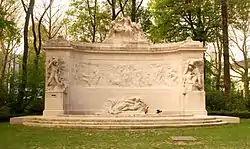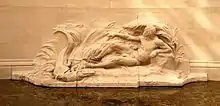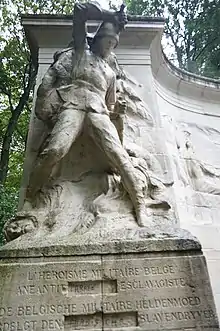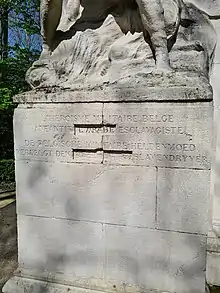Monument to the Belgian Pioneers in Congo
The 'Monument to the Belgian Pioneers in Congo' (Dutch: Monument voor de Belgische pioniers in Congo; French: Monument aux pionniers belges au Congo) is a monument in the Cinquantenaire park in Brussels, Belgium, designed by Thomas Vinçotte and honouring the Belgian efforts in the former Belgian Congo. Partly due to the proximity of the Great Mosque of Brussels, an inscription regarding the Arab slave trade is the subject of ongoing controversy.
Origins

In 1911, a national comittee was founded under the auspices of Belgian King Leopold II's successor Albert I in order to oversee the construction of the monument. As a caus of the First World War and the poor health of sculptor Thomas Vinçotte, the monument was only finished, and unveiled by Albert I and Queen Elisabeth in 1921. The monument is sculpted in white limestone of Euville. It is conceived as a romantic work with elements of art nouveau. The memorial was meant to be a patriotic hommage to the so-called 'civilising mission' of the first Belgian colonials and, more specifically, to the transfer of the Congo Free State by Leopold II to Belgium in 1908.[1]
Description
The Congo monument consists of a big curved wall divided in five sculptures which form five separate idealised scenes of Belgian pioneers in Congo. The frieze in bas-relief reads both in French and Dutch Les Explorateurs / de Ontdekkers (The Discoverers, right); le Missionnaire / de Zendeling (The Missionaries, at the centre); and les Belges au Congo / de Belgen in Congoland (The Belgians in Congo, left). On the entablature on top of the frieze, the inscription reads J'ai entrepris l'œuvre du Congo dans l'intérêt de la civilisation et pour le bien de la Belgique. Ik heb het Congowerk ondernomen in het belang der beschaving en voor het welzijn van België. Léopold II 3 juin 1906 (I have undertaken the work of the Congo in the interest of civilisation and for the well-being of Belgium. Leopold II 3 June 1906) and at the cornice Opgericht ter eere der eerste belgische baanbrekers / Monument élevé aux premiers pionniers belges (Established honouring the first Belgian pioneers).[2]
The allegorical sculpture group Het zwarte ras door België onthaald / La race noire accueillie par la Belgique (The black race welcomed by belgium) is located centrally on top of the cornice. A seated white woman with a torch in her hand lifts her veil for a semi-naked African woman who presents her children.[3]

The left side of the monument shows a group of Arabs who throw a slave to the ground, but are subjugated by a Belgian soldier. The inscription reads L'héroïsme militaire belge anéantit l'(Arabe) esclavagiste / De Belgische militaire heldenmoed verdelgt den (arabische) slavendrijver (Belgian military heroism wipes out the (Arab) slave trader). It represents the raids of baron Francis Dhanis against the Arab slave traders.[4]
At the centre of the bottom, the Congo river is allegorically depicted by a languishing Congolese and a crocodile.[5]
Controversy


Since the 1980s, the monument increasingly became the subject of controversy. On the one hand, the glorification of Belgium's colonial past was more and more contested. On the other hand, the words Arab slave trader on one of the inscriptions became a thorn in the side of the Arab Muslim population in Brussels, which is headquartered in the nearby Great Mosque of Brussels. After a complaint by the Arab League, the words Araabschen / arabe were removed in 1988.[6] The words were restored in 1992 after a demand by the Belgian nationalist Cercle royal des anciens officiers des campagnes d'Afrique, but the French version was again removed in 2005.[7] In 2011, Ecolo politician Évelyne Huytebroeck decided to include an educational caption.[8] In 2020, far right politicians from Vlaams Belang Dries Van Langenhove and Bob De Brabandere once more restored the words Araabschen / arabe, as a reaction on what they described as a "current-day Beeldenstorm and hypocritical cult of apologies".[9] The words were removed shortly thereafter.[10] In the cut-out created by the removal of the French word, the original word Arabe is written down with a marker.
| Wikimedia Commons has media related to Monument aux pionniers belges au Congo. |
References
- "Congomonument". Inventaris van het bouwkundig erfgoed - Brussels hoofdstedelijk gewest. Retrieved 2022-04-30.
- "Congomonument". Inventaris van het bouwkundig erfgoed - Brussels hoofdstedelijk gewest. Retrieved 2022-04-30.
- "Congomonument". Inventaris van het bouwkundig erfgoed - Brussels hoofdstedelijk gewest. Retrieved 2022-04-30.
- "Congomonument". Inventaris van het bouwkundig erfgoed - Brussels hoofdstedelijk gewest. Retrieved 2022-04-30.
- "Congomonument". Inventaris van het bouwkundig erfgoed - Brussels hoofdstedelijk gewest. Retrieved 2022-04-30.
- "Congomonument". Inventaris van het bouwkundig erfgoed - Brussels hoofdstedelijk gewest. Retrieved 2022-04-30.
- Bauweleers, Greet (2014-03-19). "Gecontesteerd koloniaal erfgoed en een lege sokkel". Apache.
- "Omstreden koloniaal monument krijgt bijschrift". Bruzz. 2011-06-05. Retrieved 2022-04-30.
- "Vlaams Belang 'herstelt' Congomonument in Jubelpark". HLN. 2020-07-02. Retrieved 2022-04-30.
- Romans, Stephanie (2020-07-08). "'Herstelling' van Vlaams Belang aan Congomonument weggehaald". HLN.